TOXIC EARTH
New warehouse springs up next to poison-soaked UPL explosion site
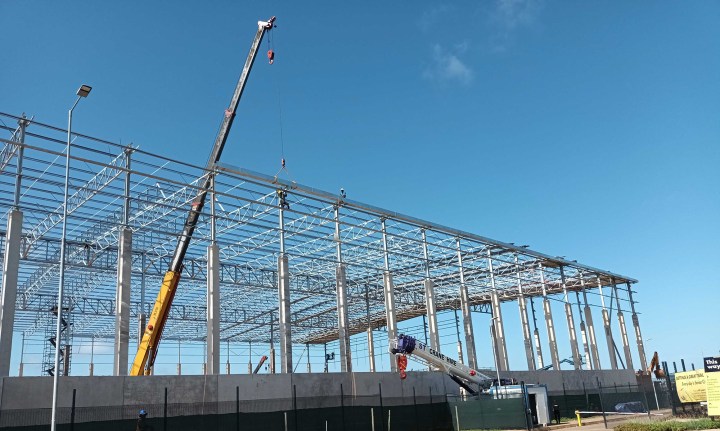
A massive warehouse is rising next to the fire-gutted UPL pesticides storehouse in Durban, raising concerns over worker safety and groundwater pollution — and whether the new tenants will be happy to occupy land still soaked with hazardous chemicals.
The Fortress property group is developing a new commercial warehouse directly adjacent to the UPL chemical site that was destroyed in an arson attack at Cornubia during the July 2021 riots.
Fortress chief executive Steven Brown insists that his company has received the required planning approval, along with “all the requisite sign-offs from relevant departments for a development of this nature”.
Fortress is the same developer that leased a general purpose warehouse to the Indian-owned UPL agrochemical giant to store over 5,500 tonnes of toxic pesticides and other chemical products next to a residential area and schools.
Government officials claimed the facility was established without a detailed hazardous risk assessment or project-specific environmental impact assessment to mitigate chemical pollution in the event of a natural disaster, accident or sabotage.
Read more in Daily Maverick: “Minister Barbara Creecy pledges clampdown on South Africa’s hidden toxic chemical storehouses after UPL disaster”
At the time, Fortress sought to shift blame to UPL, stating that Fortress ensured all relevant environmental authorisations were obtained before the (now destroyed) UPL warehouse was built.
“The (UPL) warehouse was a speculative build and the tenant came later. We point out that the tenants in turn had a legal obligation to obtain all of the approvals that they required in order to operate their business from the premises being rented,” the company said shortly after the fire.
In response to more recent questions from Our Burning Planet about Fortress’ latest warehouse development at Cornubia, Brown asserted that tests proved that risks to workers and the public were “very low” — similar to any other land in that area.
A different picture
But two specialist geohydrology reports show a very different picture, suggesting that soils underneath the UPL site (and the immediate vicinity) are still soaked with a wide variety of highly poisonous farm chemicals to a depth of six metres or more.
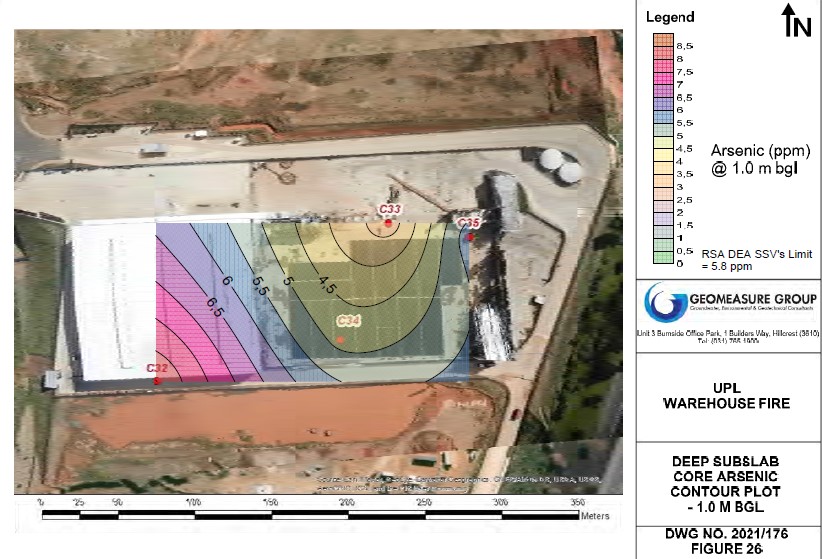
The soil beneath the UPL concrete floor is polluted with several chemical poisons. This contour map shows arsenic contamination levels one metre below UPL. (Source: Geomeasure)
Based on more than 70 underground soil samples and computer modelling results, a 345-page report from the Geomeasure Group confirms that the ground immediately below the UPL site is “significantly impacted” by pesticides and hydrocarbons.
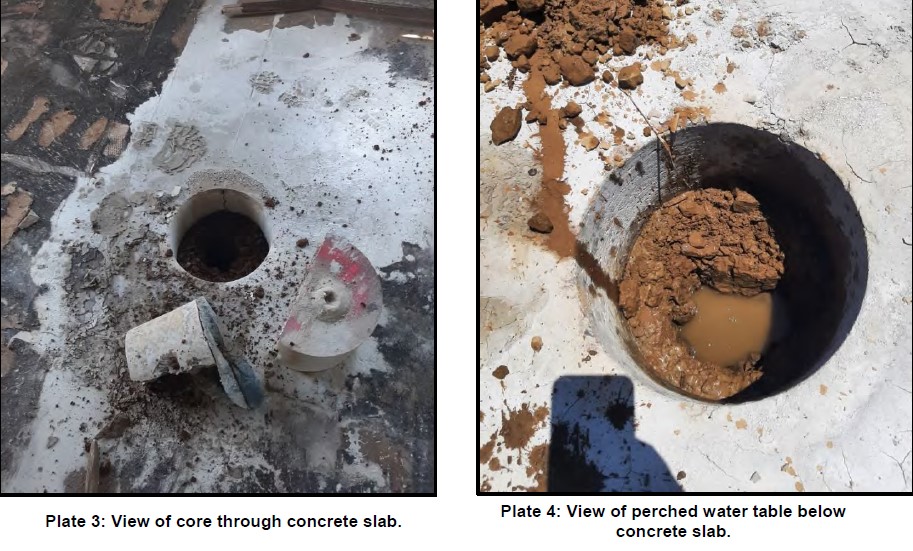
More than 70 samples of polluted soil have been collected from dozens of coring holes drilled into the UPL floor. (Source: Geomeasure)
It also reports the presence of arsenic and other chemicals with the potential to cause cancer and other serious health damage under certain conditions.
Though large volumes of toxic chemicals were washed off the site from fire-fighting water and subsequent rains into local rivers and the sea, Geomeasure says an unknown volume of chemicals also leaked underground. This was due to cracks in the UPL concrete floor caused by the very high temperatures of the chemical fire and explosion, as well as leaks into underground cable ducting cavities.
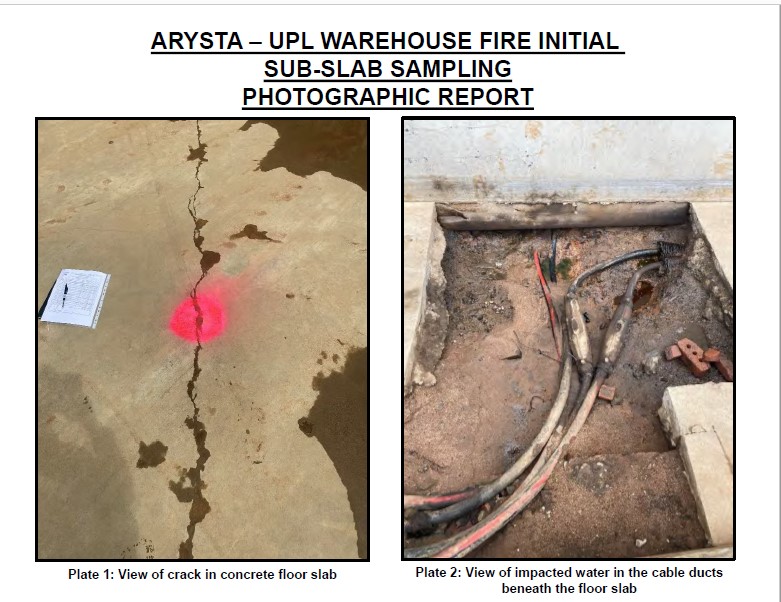
Cracks in the floor and cable ducting cavities have allowed toxic chemicals to leak into the soil and groundwater beneath the UPL warehouse floor. (Source: Geomeasure)
The pollution contour maps from Geomeasure indicate that underground chemical plumes extend beyond the old UPL warehouse on to the new site now being developed by Fortress.
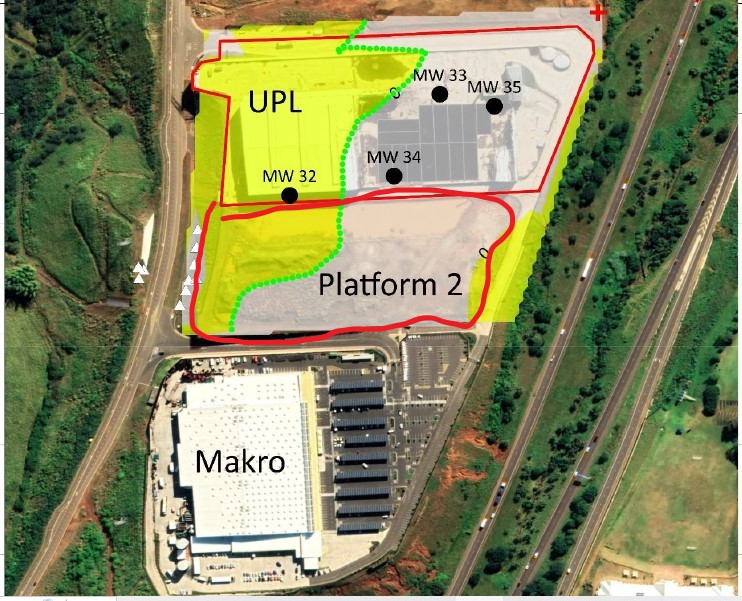
The position of the new South Platform warehouse (red line) showing its proximity to Makro and the gutted UPL storehouse. The yellow areas depict loosely packed soils from cut and fill operations. (Source: Copperleaf Consulting)
Apart from arsenic, other contaminants include heavy metals such as copper, along with herbicides and pesticides that include 2,4-D, Terbuthiron, MCPA, Ametryn and Picloram.
Overall, the Geomeasure risk assessment concludes that cancer was “not flagged” as a risk for construction workers on the UPL site once the old floor is demolished — although some of the other chemical compounds that were computer modelled did flag other human health risks via skin contact with contaminated soil.
These other (unspecified) human health risks to workers appear to be more than four times higher than risk guideline levels set by the national Environmental Affairs department.
Worryingly, Geomeasure reports that: “While workers involved in the demolition of the concrete slab will utilise personal protective equipment (PPE), occupation health monitoring undertaken at the incident site has in fact picked up impacts to some of the workers on site, despite the use of PPE.”

Extract from Geomeasure report noting health impacts on workers even when wearing PPE.
Our Burning Planet tried to establish further details of these unspecified health impacts on workers via UPL, but the company has yet to respond to questions sent on 7 December.
Pesticide data
Critically, the Geomeasure report acknowledges that its recent health risk assessment for Cornubia excluded any analysis of the thousands of tonnes of pesticides, herbicides and fungicides stored at UPL.
Instead, it was based solely on an analysis of arsenic, benzene, chlorobenzene, copper, ethylbenzene, manganese, naphthalene, trimethylbenzene and xylenes — because Geomeasure’s computer modelling software did not include any pesticide data.
The 2010 software (RISC 5) was developed originally by British Petroleum to predict pollution levels from petrol stations and refineries.
Geomeasure also reported that many of the chemical levels found beneath the UPL floor far exceed the safety screening levels set by both the US Environmental Protection Agency and the South African guideline levels for contaminated land.
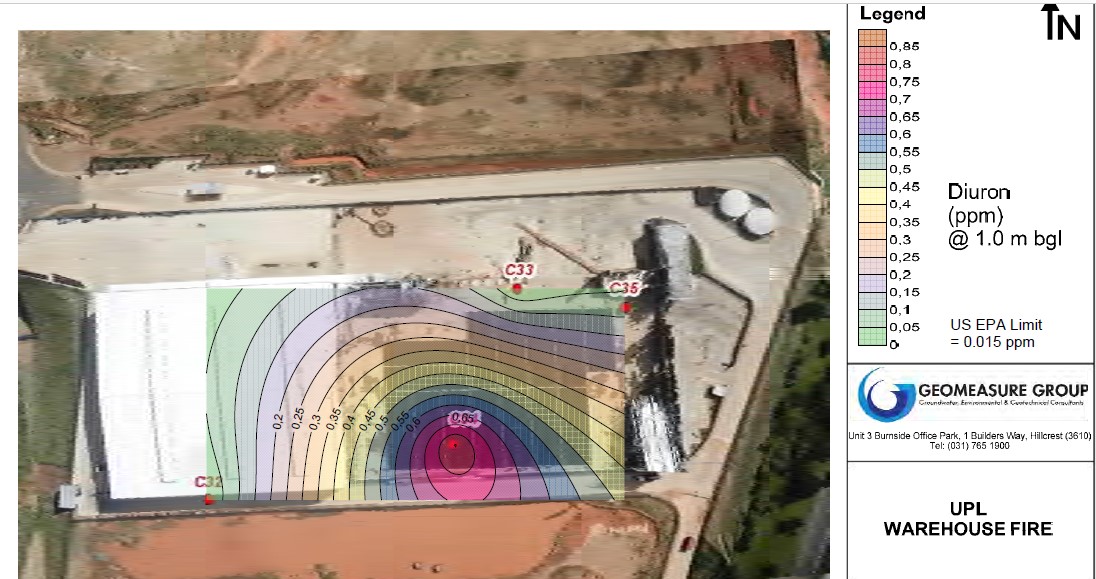
Diuron levels below the UPL concrete slab. (Source: Geomeasure)
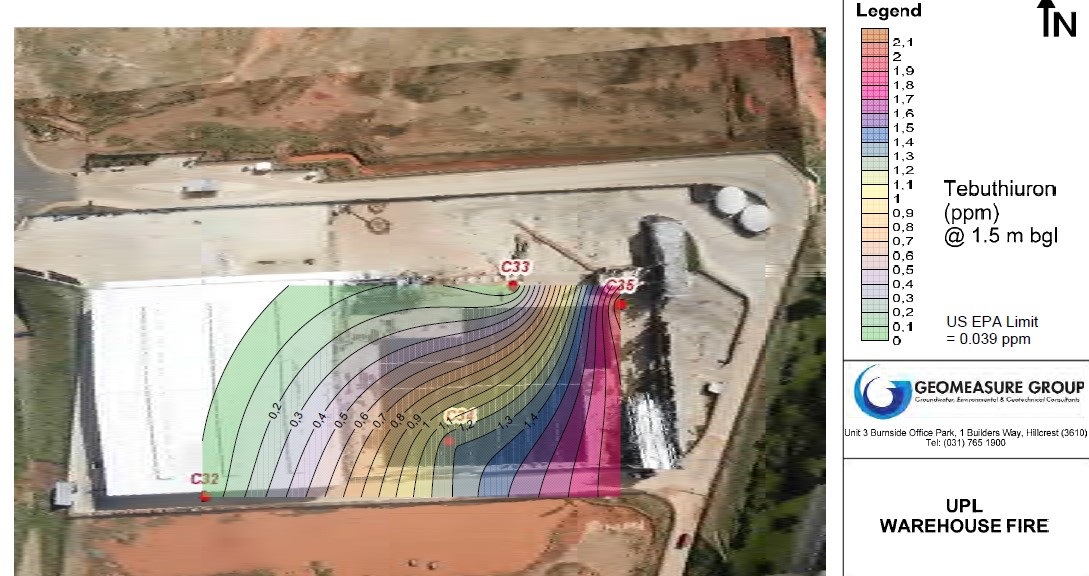
Tebuthiuron pollution levels below UPL. (Source: Geomeasure)
It records Triclopyr levels above 90 ppm in some places, as well as Tebuthioron (over 36 ppm) Ametryn (above 16 ppm) Atrazine (above 1.3 ppm), Diuron (above 5 ppm) and MCPA (above 35 ppm).
Some of these poisons and their breakdown products have been classified as possible cancer-causing agents in humans or animals, while others have been linked to liver and kidney damage, convulsions or spontaneous abortion.
Further underlining the potential severity of pollution to the soil and groundwater in the area, a separate report by senior geohydrologist Dr Digby Gold notes that the UPL warehouse was built on a new platform created by “cutting and filling”.
This process involves extensive earth-moving operations in which soil and rock from high-lying areas are used to fill in lower-lying areas to create level land.
Groundwater
This is significant, he notes, because the “fill” material remains largely uncompacted and therefore provides the potential for “largely unrestrained through-flow of groundwater”.
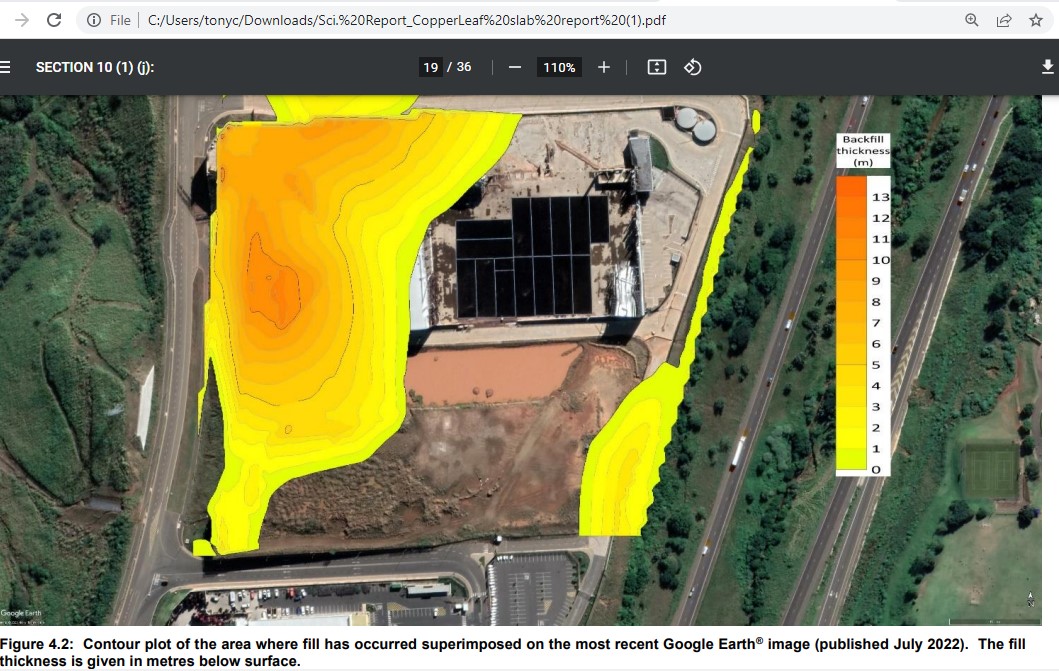
The filled areas around the UPL and Makro sites are shown in yellow shading. (Source: Copperleaf Consulting)
This appears to contradict Fortress’ assertion that the risks to workers from soil contact at the new adjoining warehouse site are “very low”.
In his report, Gold emphasises the need to dig several more monitoring wells (up to 45m deep) in the loosely compacted “filled” sections to help determine the extent of the pollution more accurately, and t0 plan future remediation (if necessary).
Depending on the severity and extent of the soil/groundwater pollution, an extensive remediation process may become necessary — similar to the R50-million “pump-and-treat” project by the Bayer/Lanxess chemical group that began in Durban in 2006 to suck up hexavalent chromium.
This deadly chemical leaked from Bayer’s factory in Merebank before spreading beneath a local school and several homes. The company said the leakage of hexavalent chromium could have started in the late 1940s and continued to the early 1990s.
The Bayer clean-up operation in South Durban was expected to last for up to a decade.
The new warehouse
What does all this mean for the Fortress group, the new warehouse tenant and neighbouring residents if land and water beneath the new Cornubia warehouse site are extensively polluted?
According to Fortress, the new warehouse is being developed for commercial industrial use and the site was not impacted by firewater runoff.
“Tests and assessments were conducted on the planned land use on the South Platform (commercial /industrial) and potential exposure pathways to receptor and risk of exposure to soil or soil-borne dusts was determined to be very low,” Brown said in response to our questions.

Geomeasure’s summary of the potential health risks to workers.
“During the construction phase, potential risks have been mitigated with PPE and health and safety consultants have prepared a health and safety plan in accordance with the assessment results.
“We have the required plan approval with all the requisite sign-offs from relevant departments for a development of this nature.”
On whether it might be necessary for the new warehouse tenant to leave spaces unoccupied to accommodate new pump and treat stations (and monitoring boreholes) when designing new interior warehouse facilities, Brown said:
Visit Daily Maverick’s home page for more news, analysis and investigations
“It is premature to comment on this at this stage given we are not yet redeveloping the specific site which was occupied by UPL. Once we do begin that, we will consult with our professional team and experts on the best approach to ensure we do not place anyone at unnecessary risk. This may involve some of the items you mention but it would be too early to confirm at this stage.”
On whether Fortress had made construction workers aware of the potentially significant adverse risks to their health and safety while digging and building on this chemically contaminated land, Brown said:
“As noted above, we are following all the required health and safety protocols on the site we are working on, which again is not the same site as UPL occupied.”
(In fact, the new warehouse directly abuts the old UPL site)
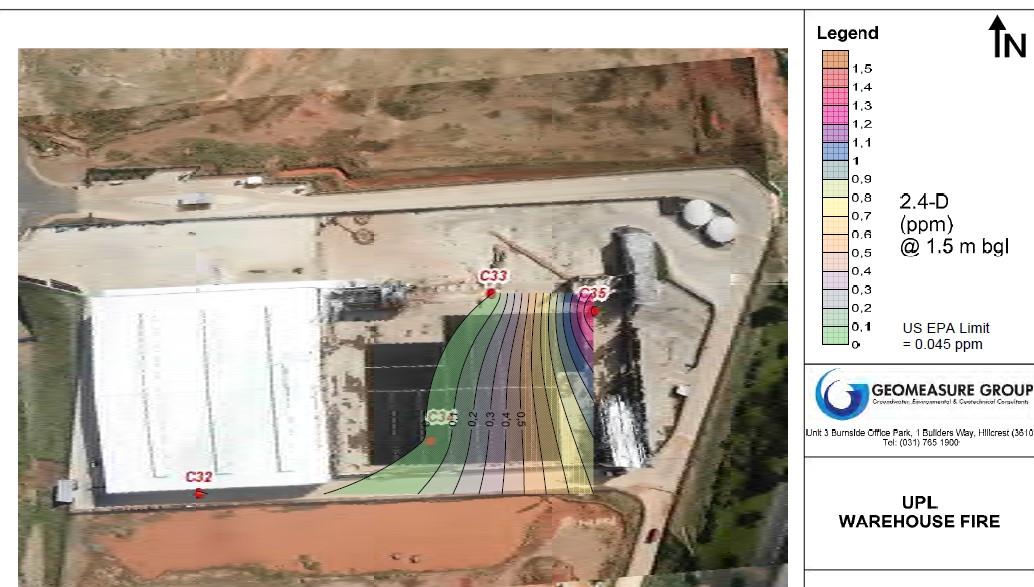
2.4-D pesticide levels at 1.5m below ground level. (Source: Geomeasure)
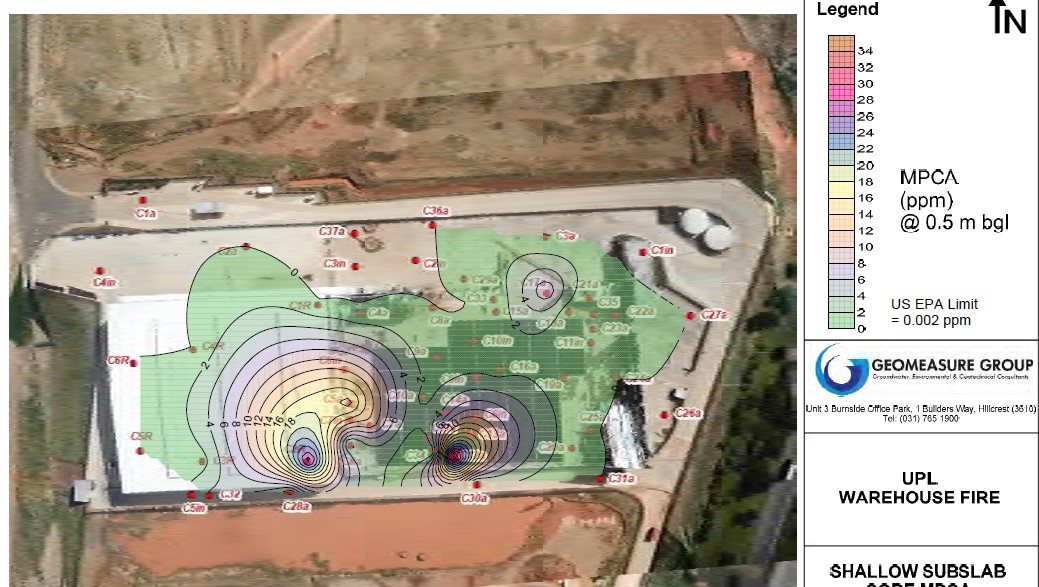
Underground levels of MCPA contamination far exceed guideline levels of the US Environment Protection Agency. (Source: Geomeasure)
UPL plans
The other big question still unanswered by Fortress or UPL is whether the Indian-owned farm poisons giant wants to re-establish its operations at Cornubia.
Soon after the chemical warehouse went up in flames 18 months ago, senior UPL executive Jan Botha expressed the hope that the warehouse would be rebuilt, allowing his company to resume operations swiftly.
We asked Brown whether Fortress was open to such a move. And if so, under what conditions, and would neighbours be consulted beforehand?
In response, Fortress said: “Regarding UPL — this is still ongoing, and along with UPL, we will update all stakeholders once concluded.”
UPL was also asked whether it hoped to reoccupy the Cornubia site. No formal response has been received. DM/OBP







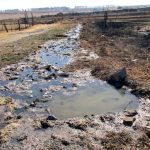











 Become an Insider
Become an Insider
Comments - Please login in order to comment.